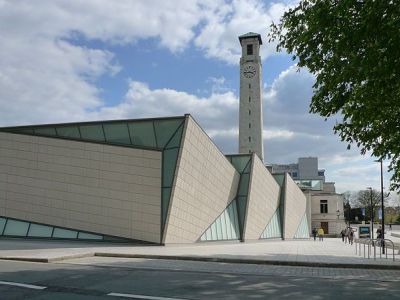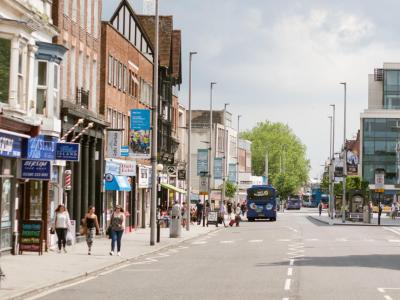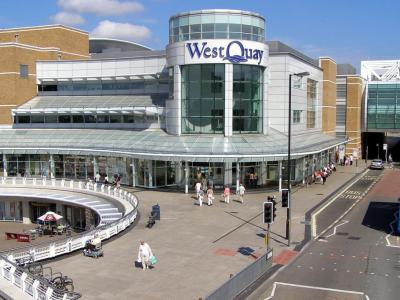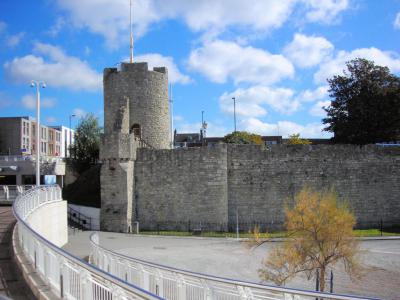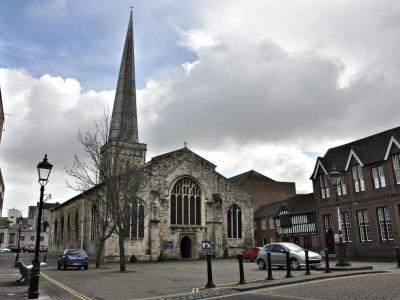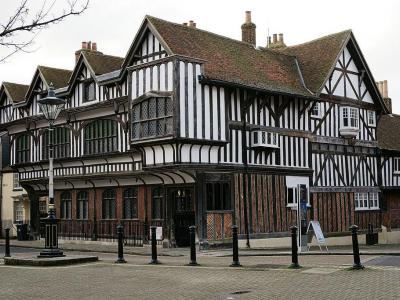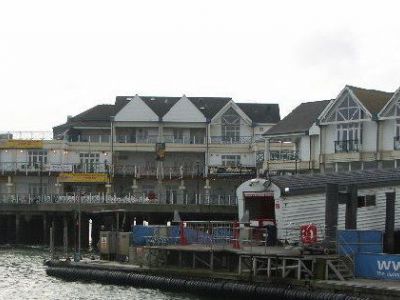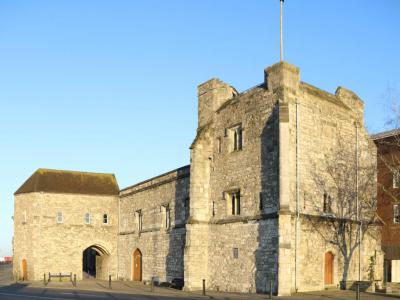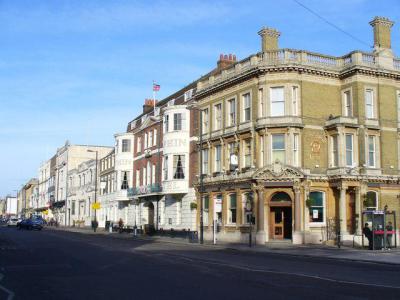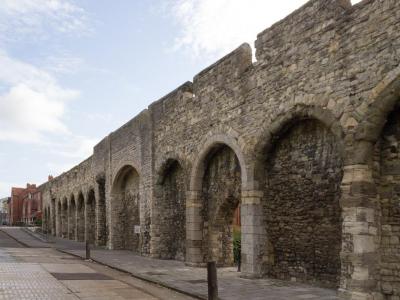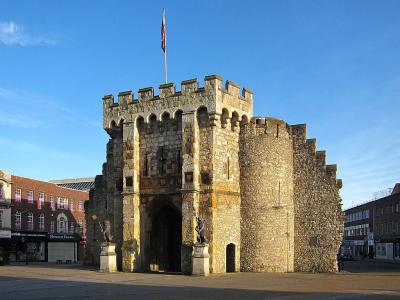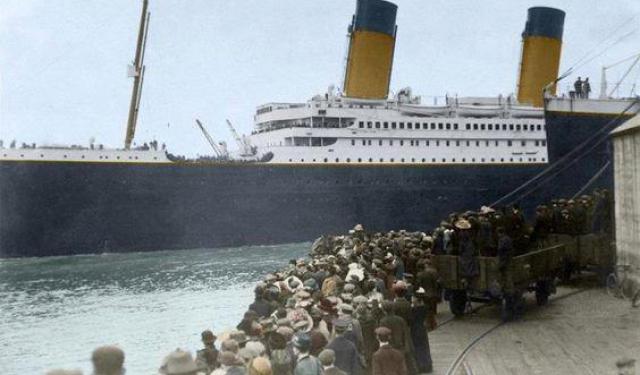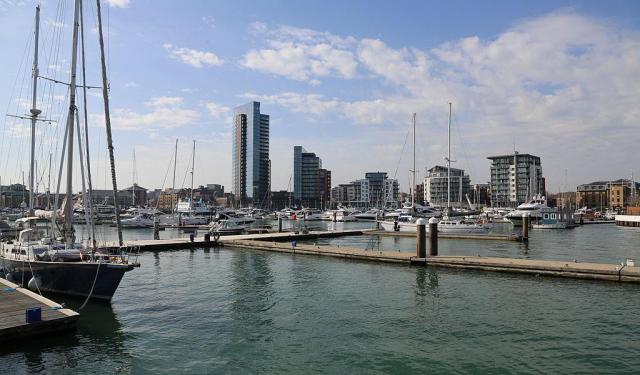Southampton Introduction Walking Tour (Self Guided), Southampton
Southampton is an important port city with a long history. Archaeological records indicate that the area has been settled since the Stone Age. The Romans had a settlement here, and the Anglo-Saxons later settled in the area.
Southampton became a major port after the 1066 Norman Conquest. Southampton's impressive walls were built following a French incursion in the 1300s.
The Mayflower originally departed Southampton before turning back to Portsmouth due to bad weather.
The ill-fated Titanic departed Southampton in 1912 on its maiden and final voyage. Over 500 of the Titanic's crew listed Southampton as their home address.
Visit the 800-year-old Tudor House and Gardens to get insight into Southampton's history. Visitors can see how different rooms would have been set up and admire many precious artifacts from different centuries.
Many parts of the original town wall have been preserved. Visitors can walk the wall and admire its many impressive remaining gates and towers.
Bargate was built around 1180 and was the main entrance to Southampton. This impressive structure was used for many purposes over the centuries. Today's visitors can see the newly restored lion sculptures standing guard.
Other worthwhile stops along the wall include the 13th-century God's House Tower and the Arundel Tower.
To find out more about Southampton's connection with the Titanic, visit the SeaCity Museum. The SeaCity Museum's Titanic Story exhibition further explores the lives of the crew who hailed from Southampton. Another exhibition focuses on Southampton's importance as a global port city.
St. Michael's Church was founded in 1070 and is Southampton's oldest building still in use. This beautiful church features several gorgeous and unique details and artifacts.
For shopping, enjoy strolling historic Above Bar Street, or enjoy retail therapy at the modern Westquay.
Southampton became a major port after the 1066 Norman Conquest. Southampton's impressive walls were built following a French incursion in the 1300s.
The Mayflower originally departed Southampton before turning back to Portsmouth due to bad weather.
The ill-fated Titanic departed Southampton in 1912 on its maiden and final voyage. Over 500 of the Titanic's crew listed Southampton as their home address.
Visit the 800-year-old Tudor House and Gardens to get insight into Southampton's history. Visitors can see how different rooms would have been set up and admire many precious artifacts from different centuries.
Many parts of the original town wall have been preserved. Visitors can walk the wall and admire its many impressive remaining gates and towers.
Bargate was built around 1180 and was the main entrance to Southampton. This impressive structure was used for many purposes over the centuries. Today's visitors can see the newly restored lion sculptures standing guard.
Other worthwhile stops along the wall include the 13th-century God's House Tower and the Arundel Tower.
To find out more about Southampton's connection with the Titanic, visit the SeaCity Museum. The SeaCity Museum's Titanic Story exhibition further explores the lives of the crew who hailed from Southampton. Another exhibition focuses on Southampton's importance as a global port city.
St. Michael's Church was founded in 1070 and is Southampton's oldest building still in use. This beautiful church features several gorgeous and unique details and artifacts.
For shopping, enjoy strolling historic Above Bar Street, or enjoy retail therapy at the modern Westquay.
How it works: Download the app "GPSmyCity: Walks in 1K+ Cities" from Apple App Store or Google Play Store to your mobile phone or tablet. The app turns your mobile device into a personal tour guide and its built-in GPS navigation functions guide you from one tour stop to next. The app works offline, so no data plan is needed when traveling abroad.
Southampton Introduction Walking Tour Map
Guide Name: Southampton Introduction Walking Tour
Guide Location: England » Southampton (See other walking tours in Southampton)
Guide Type: Self-guided Walking Tour (Sightseeing)
# of Attractions: 11
Tour Duration: 2 Hour(s)
Travel Distance: 3.3 Km or 2.1 Miles
Author: Maia
Sight(s) Featured in This Guide:
Guide Location: England » Southampton (See other walking tours in Southampton)
Guide Type: Self-guided Walking Tour (Sightseeing)
# of Attractions: 11
Tour Duration: 2 Hour(s)
Travel Distance: 3.3 Km or 2.1 Miles
Author: Maia
Sight(s) Featured in This Guide:
- SeaCity Museum
- Above Bar Street
- Westquay
- Arundel Tower
- St. Michael's Church
- Tudor House Museum & Garden
- Town Quay
- God's House Tower
- High Street
- Southampton Town Wall
- Bargate
1) SeaCity Museum (must see)
SeaCity Museum opened on April 10, 2012, on the 100th anniversary of the Titanic's departure from Southampton. SeaCity Museum is housed in a building that was previously used as a court and police station.
The museum is home to two permanent exhibitions. One is focused on Southampton's place as a strategic shipping destination. The second permanent exhibition explores Southampton's connection to the RMS Titanic. An additional modern pavilion hosts temporary exhibitions. The Pavillion was newly constructed for the museum and features three interlocking bays which emulate a ship's bow.
The Gateway to the World exhibition focuses on Southampton as a vital shipping hub. The exhibition features a seven-meter-long Queen Mary replica.
Southampton's Titanic Story exhibition views the Titanic tragedy through the eyes of the ship's crew. Most of Titanic's crew listed Southampton as their home address. The exhibition features a courtroom with audiovisual elements to show scenes from the British inquiry into the tragedy.
The exhibition includes audio recordings from Titanic survivors. Interactive displays allow visitors to steer the ship or stoke its engines.
When visitors enter the exhibition, they are guided to view the civic center clock tower through a roof light. This clock tower is the approximate height of one of Titanic's four funnels and gives visitors a feeling for the massive scale of the doomed ship.
The museum is home to two permanent exhibitions. One is focused on Southampton's place as a strategic shipping destination. The second permanent exhibition explores Southampton's connection to the RMS Titanic. An additional modern pavilion hosts temporary exhibitions. The Pavillion was newly constructed for the museum and features three interlocking bays which emulate a ship's bow.
The Gateway to the World exhibition focuses on Southampton as a vital shipping hub. The exhibition features a seven-meter-long Queen Mary replica.
Southampton's Titanic Story exhibition views the Titanic tragedy through the eyes of the ship's crew. Most of Titanic's crew listed Southampton as their home address. The exhibition features a courtroom with audiovisual elements to show scenes from the British inquiry into the tragedy.
The exhibition includes audio recordings from Titanic survivors. Interactive displays allow visitors to steer the ship or stoke its engines.
When visitors enter the exhibition, they are guided to view the civic center clock tower through a roof light. This clock tower is the approximate height of one of Titanic's four funnels and gives visitors a feeling for the massive scale of the doomed ship.
2) Above Bar Street
Above Bar Street is the part of High Street north of the Bargate. Southampton's population outgrew the town walls, and by the mid-19th century, Above Bar Street became Southampton's central business area.
Today, Above Bar Street is Southampton's central shopping district. Visitors will find favorite retailers, book stores, bars, restaurants, and cafes.
Above Bar Street provides access to several urban parks. Visitors can stroll through Palmerston Park and enjoy open spaces and beautiful flowers. Guildhall Square is a popular meeting site for events and festivals.
In Watt's Park, visitors can view the Southampton Cenotaph. The Southampton Cenotaph is a World War I memorial and features the names of fallen soldiers from the Southampton area. East Park is also located along Above Bar Street and provides additional walking trails.
Today, Above Bar Street is Southampton's central shopping district. Visitors will find favorite retailers, book stores, bars, restaurants, and cafes.
Above Bar Street provides access to several urban parks. Visitors can stroll through Palmerston Park and enjoy open spaces and beautiful flowers. Guildhall Square is a popular meeting site for events and festivals.
In Watt's Park, visitors can view the Southampton Cenotaph. The Southampton Cenotaph is a World War I memorial and features the names of fallen soldiers from the Southampton area. East Park is also located along Above Bar Street and provides additional walking trails.
3) Westquay
Westquay is a prominent shopping and leisure center located in the heart of Southampton. Spanning an impressive 95,600 square meters (over 1 million square feet), it hosts approximately 130 shops, including renowned retailers like John Lewis, Marks & Spencer, Zara, Schuh, Waterstones, Hollister Company, and Apple. Its central location, near the city’s docks, offers multiple entrances from Above Bar Street, Portland Terrace, and Harbour Parade, making it highly accessible to both locals and visitors.
Construction on Westquay began in 1997 after the demolition of the Daily Echo building and the Pirelli Cable Works, with the northern part of the center opening on 28 September 2000. A multi-story car park and a three-tier car park beneath the center provide ample parking space for shoppers.
The shopping center has seen several changes in its stores over the years. The John Lewis store, a key anchor retailer, replaced the former Tyrrell & Green department store, a change that initially stirred mixed feelings among locals. Marks & Spencer also relocated from Above Bar Street to become the second anchor tenant.
Westquay’s retail lineup has evolved since its opening, with stores like Tower Records giving way to other retailers such as Pret a Manger, and New Look relocating and expanding into the old Waitrose space. The addition of a Lego store and the reintroduction of a Little Waitrose within John Lewis further diversified the center's offerings. A highlight for the center was the opening of the first Hollister store outside of the extended London area in 2009, underscoring Westquay’s status as a major retail destination in the region.
Westquay continues to be a dynamic hub for shopping and leisure, reflecting the evolving needs and preferences of Southampton's residents and visitors alike.
Construction on Westquay began in 1997 after the demolition of the Daily Echo building and the Pirelli Cable Works, with the northern part of the center opening on 28 September 2000. A multi-story car park and a three-tier car park beneath the center provide ample parking space for shoppers.
The shopping center has seen several changes in its stores over the years. The John Lewis store, a key anchor retailer, replaced the former Tyrrell & Green department store, a change that initially stirred mixed feelings among locals. Marks & Spencer also relocated from Above Bar Street to become the second anchor tenant.
Westquay’s retail lineup has evolved since its opening, with stores like Tower Records giving way to other retailers such as Pret a Manger, and New Look relocating and expanding into the old Waitrose space. The addition of a Lego store and the reintroduction of a Little Waitrose within John Lewis further diversified the center's offerings. A highlight for the center was the opening of the first Hollister store outside of the extended London area in 2009, underscoring Westquay’s status as a major retail destination in the region.
Westquay continues to be a dynamic hub for shopping and leisure, reflecting the evolving needs and preferences of Southampton's residents and visitors alike.
4) Arundel Tower
This 60-foot-tall half drum tower was initially constructed in the 13th century. It was first known as Corner Tower and offered defensive forces a commanding view out to sea. It was re-named Arundel Tower after Sir John Arundel, governor of Southampton Castle in the 1300s.
During the 16th century, shoemakers, curriers, saddlers, and cobblers were charged with the tower's defense, and the tower became known as the Shoemaker's Tower.
Before the 20th century, its location near the sea has caused saltwater damage, and the tower has needed constant repair over the centuries. In fact, early illustrations show seawater lapping at the tower's foundations. Its exposed location near sea winds earned the tower the nickname "Windwhistle".
In the 20th century, a land reclamation program increased the size of the docks, and the sea is now further away.
Visitors can climb the Arundel Tower and enjoy views of the town wall.
During the 16th century, shoemakers, curriers, saddlers, and cobblers were charged with the tower's defense, and the tower became known as the Shoemaker's Tower.
Before the 20th century, its location near the sea has caused saltwater damage, and the tower has needed constant repair over the centuries. In fact, early illustrations show seawater lapping at the tower's foundations. Its exposed location near sea winds earned the tower the nickname "Windwhistle".
In the 20th century, a land reclamation program increased the size of the docks, and the sea is now further away.
Visitors can climb the Arundel Tower and enjoy views of the town wall.
5) St. Michael's Church
This impressive church is Southampton's oldest building still in use. Saint Michael's Chruch was founded in 1070. Henry II gave the church to the monks of Saint Denys, who administered the church until the 1537 Dissolution.
Saint Michael's was enlarged during the 13th century as Southampton prospered. The first spire was added in the 15th century and renovated with an additional 9 feet in 1887. The spire is now 165 feet high.
While much of Southhampton was damaged during WWII, the church and spire escaped significant damage.
The East Window depicts Southampton's five medieval churches. Unfortunately, Saint Michael's is the only one still standing. The West Window portrays Saint Michael killing the dragon.
The unique font dates to the 12th century and was created from a single block of black marble.
One of the brass lecterns was rescued from Holyrood Church. This pulpit dates to the 14th or 15th century and is the most impressive in England. It depicts an eagle with separated wing feathers.
Saint Michael's church is home to several tombs. The most famous tomb belongs to Sir Richard Lyster, who was the chief justice of the King's Bench. He was interred here in 1554.
Saint Michael's was enlarged during the 13th century as Southampton prospered. The first spire was added in the 15th century and renovated with an additional 9 feet in 1887. The spire is now 165 feet high.
While much of Southhampton was damaged during WWII, the church and spire escaped significant damage.
The East Window depicts Southampton's five medieval churches. Unfortunately, Saint Michael's is the only one still standing. The West Window portrays Saint Michael killing the dragon.
The unique font dates to the 12th century and was created from a single block of black marble.
One of the brass lecterns was rescued from Holyrood Church. This pulpit dates to the 14th or 15th century and is the most impressive in England. It depicts an eagle with separated wing feathers.
Saint Michael's church is home to several tombs. The most famous tomb belongs to Sir Richard Lyster, who was the chief justice of the King's Bench. He was interred here in 1554.
6) Tudor House Museum & Garden (must see)
Tudor House shows visitors what life in Southampton was like during Tudor times. Tudor House is one of Southampton's most important buildings and brings 800 years of history to life.
Instead of simply viewing objects in glass cases, the museum immerses visitors in history with beautiful presentations and interactive displays.
Visitors will start with an interactive presentation. Spirits from the past tell you about Tudor House and give you glimpses into its history.
The museum has many displays of artifacts from ancient history to the present. Visitors can admire a medieval jewel casket, Victorian stuffed birds, a pair of shoes from the 1920s. One of the more intriguing displays hosts glass panes painted with bird depictions.
The Book of Hours is one of the museum's most precious items. This very small book is very fragile and dates to around 1480. The Book of Hours is a hand-illustrated prayer book written in Flemish with Latin flourishes.
The sedan chair was a popular way for wealthy people to travel around town. A mid-18th-century sedan chair for hire is on display.
The penny-farthing bicycle is another popular item. This bicycle features one very large wheel and one very small wheel and was popular in the late 19th century.
Kids and adults alike will be amazed by the Tudor dollhouses, complete with opening doors and windows and small figures. Various displays recreate daily life in Tudor times. Visitors can see a historic kitchen and learn about food prep.
The gardens are beautiful and include ancient canons. The gardens have been planned to represent a garden from the 1500s and include formal pathways and low-cut hedges. On the way out of the museum and gardens, you can visit the small attic.
Why You Should Visit:
Tudor House dates back to 1348 when a wealthy merchant owned it. Different families have owned the house throughout the centuries, and today's visitors can enjoy a complete immersion into Southampton's history.
Tips:
The Tudor House Cafe serves fabulous cream teas and gives visitors a gorgeous view of the gardens.
Instead of simply viewing objects in glass cases, the museum immerses visitors in history with beautiful presentations and interactive displays.
Visitors will start with an interactive presentation. Spirits from the past tell you about Tudor House and give you glimpses into its history.
The museum has many displays of artifacts from ancient history to the present. Visitors can admire a medieval jewel casket, Victorian stuffed birds, a pair of shoes from the 1920s. One of the more intriguing displays hosts glass panes painted with bird depictions.
The Book of Hours is one of the museum's most precious items. This very small book is very fragile and dates to around 1480. The Book of Hours is a hand-illustrated prayer book written in Flemish with Latin flourishes.
The sedan chair was a popular way for wealthy people to travel around town. A mid-18th-century sedan chair for hire is on display.
The penny-farthing bicycle is another popular item. This bicycle features one very large wheel and one very small wheel and was popular in the late 19th century.
Kids and adults alike will be amazed by the Tudor dollhouses, complete with opening doors and windows and small figures. Various displays recreate daily life in Tudor times. Visitors can see a historic kitchen and learn about food prep.
The gardens are beautiful and include ancient canons. The gardens have been planned to represent a garden from the 1500s and include formal pathways and low-cut hedges. On the way out of the museum and gardens, you can visit the small attic.
Why You Should Visit:
Tudor House dates back to 1348 when a wealthy merchant owned it. Different families have owned the house throughout the centuries, and today's visitors can enjoy a complete immersion into Southampton's history.
Tips:
The Tudor House Cafe serves fabulous cream teas and gives visitors a gorgeous view of the gardens.
7) Town Quay
Town Quay in Southampton has a rich history that dates back to its earliest mention in 1411 when it was known as Watergate Quay. The quay underwent major transformations in the 19th century, with the modern Town Quay taking shape in the early 1800s. A key development in 1871 was the introduction of a horse-drawn tramway, connecting the quay to the railway, which was later upgraded to light locomotives in 1876. During World War I, the quay played a crucial role in military logistics, seeing extensive use by military barges.
By the 1930s, commercial traffic had shifted to other locations, leaving Town Quay to handle more passenger services, a trend that continues today. The quay is now home to a bustling marina, and both the Hythe Ferry and the Red Funnel high-speed services operate from here. The quay retains historical significance through buildings like the Geddes Warehouse, which has been repurposed into a boutique hotel and restaurant, and the Harbor Board Office, a structure from the 1920s that still stands.
Town Quay also serves as a commercial hub, housing waterside offices for a variety of businesses, including tech companies, marine enterprises, and consultants. The quay continues to evolve while maintaining its historical charm, with a Grade II listed status on key buildings and modern conveniences that cater to both business and leisure.
By the 1930s, commercial traffic had shifted to other locations, leaving Town Quay to handle more passenger services, a trend that continues today. The quay is now home to a bustling marina, and both the Hythe Ferry and the Red Funnel high-speed services operate from here. The quay retains historical significance through buildings like the Geddes Warehouse, which has been repurposed into a boutique hotel and restaurant, and the Harbor Board Office, a structure from the 1920s that still stands.
Town Quay also serves as a commercial hub, housing waterside offices for a variety of businesses, including tech companies, marine enterprises, and consultants. The quay continues to evolve while maintaining its historical charm, with a Grade II listed status on key buildings and modern conveniences that cater to both business and leisure.
8) God's House Tower
God's House Tower, located at the southeast corner of Southampton's town walls, is a historic 13th-century gatehouse that once provided access to the town from the Platform and Town Quay. Originally known as Saltmarsh Gate due to its proximity to marshlands, it later became known as God's House Gate because of its location near God's House Hospital, founded in 1168 to provide refuge for travelers.
Over the centuries, the tower evolved from a simple gatehouse to a significant fortification. Following a French raid in 1338, the town's defenses were strengthened, and in 1417, a two-story gallery and three-story tower were added, designed specifically to support cannon fire. This tower, equipped with eight gunports and rooftop firing points, helped the town gunner protect the sluices controlling seawater flow into a tidal moat that powered a nearby water mill.
In the following centuries, as Southampton's need for strong defenses diminished, God's House Tower transitioned into various roles, from a house of correction in the 1700s to the town jail by 1786. By 1855, a new prison was built elsewhere, and the tower fell into disuse until it was repurposed for storage in 1876. The building's exterior was cleaned and restored during this time, though part also served as a mortuary.
In 1961, God's House Tower became the Museum of Archaeology, showcasing Southampton's history, but closed in 2011 with exhibits moved to SeaCity Museum. Reopened in 2019 as an arts and heritage venue, it now features galleries, panoramic rooftop views, and a Hoxton Bakery branch. The Grade I listed building, known for its stone rubble construction, retains historical features like portcullis grooves, cinquefoil windows, and keyhole gunports, alongside traces of its tidal sluices and mural stairway.
Over the centuries, the tower evolved from a simple gatehouse to a significant fortification. Following a French raid in 1338, the town's defenses were strengthened, and in 1417, a two-story gallery and three-story tower were added, designed specifically to support cannon fire. This tower, equipped with eight gunports and rooftop firing points, helped the town gunner protect the sluices controlling seawater flow into a tidal moat that powered a nearby water mill.
In the following centuries, as Southampton's need for strong defenses diminished, God's House Tower transitioned into various roles, from a house of correction in the 1700s to the town jail by 1786. By 1855, a new prison was built elsewhere, and the tower fell into disuse until it was repurposed for storage in 1876. The building's exterior was cleaned and restored during this time, though part also served as a mortuary.
In 1961, God's House Tower became the Museum of Archaeology, showcasing Southampton's history, but closed in 2011 with exhibits moved to SeaCity Museum. Reopened in 2019 as an arts and heritage venue, it now features galleries, panoramic rooftop views, and a Hoxton Bakery branch. The Grade I listed building, known for its stone rubble construction, retains historical features like portcullis grooves, cinquefoil windows, and keyhole gunports, alongside traces of its tidal sluices and mural stairway.
9) High Street
As far back as the 1500s, Southampton's High Street was recognized as one of England's cleanest and most beautiful. It was originally known as English Street in medieval times.
English Street got its name since it was the artery between three English-speaking parishes in the community. All Saints, Saint Lawrence, and Holy Rood were all connected through here. Logically, French Street linked the French-speaking sections of town, including Saint Michael and Saint John.
Unfortunately, German bombing campaigns during World War II devastated many parts of the city, including High Street. What was left after the war was a shadow of the historical glory that once stood here. Even though many buildings were destroyed, the modern buildings stand on medieval cellars and vaults.
Many bank buildings did survive the war, most of which were from the late 19th century. You can still see the National Westminster Bank, Midland Bank, and Barclay's Bank. The old Bank of England building at Nos. 31-33 is now a public house.
At No. 56, you'll find the former Oakley and Watling Fruit and Vegetable Merchants building. Its facade is ornately decorated with fruits.
English Street got its name since it was the artery between three English-speaking parishes in the community. All Saints, Saint Lawrence, and Holy Rood were all connected through here. Logically, French Street linked the French-speaking sections of town, including Saint Michael and Saint John.
Unfortunately, German bombing campaigns during World War II devastated many parts of the city, including High Street. What was left after the war was a shadow of the historical glory that once stood here. Even though many buildings were destroyed, the modern buildings stand on medieval cellars and vaults.
Many bank buildings did survive the war, most of which were from the late 19th century. You can still see the National Westminster Bank, Midland Bank, and Barclay's Bank. The old Bank of England building at Nos. 31-33 is now a public house.
At No. 56, you'll find the former Oakley and Watling Fruit and Vegetable Merchants building. Its facade is ornately decorated with fruits.
10) Southampton Town Wall (must see)
Southampton has had some defensive structures since occupied by the Romans. French forces attacked Southampton in 1338. However, the defenses were not adequate.
Work on the new wall began in the 1360s. Eventually, the wall was 1.25 miles long and wholly enclosed Southampton. The impressive wall housed 29 towers and eight gates. The towers were built to house cannons, which was a new technology in the 1300s.
The walls were used for defense throughout the 15th century. By the 18th century, the walls and gatehouses fell into disrepair. More recently, efforts have been made to preserve these historic walls.
Today, about half of the length of the original walls is still visible. Only 13 of the original 29 towers and six of the original gates still stand. God's House Tower still stands and is one of the first urban buildings to be purpose-built to hold gunpowder weapons. God's House Tower is three stories high and is next to God's House Gate.
Arundel tower still stands and is a popular attraction. The west walls are home to a unique feature called The Arcades. They are a series of arches built in the 14th century to reinforce the original 12th and 13th-century walls.
Work on the new wall began in the 1360s. Eventually, the wall was 1.25 miles long and wholly enclosed Southampton. The impressive wall housed 29 towers and eight gates. The towers were built to house cannons, which was a new technology in the 1300s.
The walls were used for defense throughout the 15th century. By the 18th century, the walls and gatehouses fell into disrepair. More recently, efforts have been made to preserve these historic walls.
Today, about half of the length of the original walls is still visible. Only 13 of the original 29 towers and six of the original gates still stand. God's House Tower still stands and is one of the first urban buildings to be purpose-built to hold gunpowder weapons. God's House Tower is three stories high and is next to God's House Gate.
Arundel tower still stands and is a popular attraction. The west walls are home to a unique feature called The Arcades. They are a series of arches built in the 14th century to reinforce the original 12th and 13th-century walls.
11) Bargate
Bargate is an impressive medieval gatehouse that was built around 1180. Located in the center of High Street, Bargate was the traditional entrance and main gateway to Southampton. Bargate is praised as the finest and most complex gateway in England.
Bargate was built with flint and stone. In 1280, builders added imposing drum towers on the north side. Then, in the early 1400s, the north front was added.
At some point during the 1400s, Southampton began using Bargate as a prison. Then, during the 16th century, Southampton's court leet started meeting in the Bargate.
The Bargate was used as Southhampton's guildhall and market for centuries. Visitors can still see the vaults where merchants stored wine.
The fabled lion sculptures were added during the 16th century. The lions are thought to symbolize the legend of Sir Bevois, who founded Southhampton. Sir Bevios is the subject of many heroic legends, including a legend that tells of Sir Bevois slaying two lions to protect a princess. The lions were restored in 2020.
Visitors will find 11 heraldic shields on the Bargate's north side. Unfortunately, the original shields decayed with time, and many attempts have been made to restore them.
In 1899, 1914, and 1923, council members debated demolishing Bargate to accommodate increasing road traffic. Instead, the town council decided to separate Bargate from the town walls.
During WWII, Bargate was used as an air-raid shelter.
Bargate was built with flint and stone. In 1280, builders added imposing drum towers on the north side. Then, in the early 1400s, the north front was added.
At some point during the 1400s, Southampton began using Bargate as a prison. Then, during the 16th century, Southampton's court leet started meeting in the Bargate.
The Bargate was used as Southhampton's guildhall and market for centuries. Visitors can still see the vaults where merchants stored wine.
The fabled lion sculptures were added during the 16th century. The lions are thought to symbolize the legend of Sir Bevois, who founded Southhampton. Sir Bevios is the subject of many heroic legends, including a legend that tells of Sir Bevois slaying two lions to protect a princess. The lions were restored in 2020.
Visitors will find 11 heraldic shields on the Bargate's north side. Unfortunately, the original shields decayed with time, and many attempts have been made to restore them.
In 1899, 1914, and 1923, council members debated demolishing Bargate to accommodate increasing road traffic. Instead, the town council decided to separate Bargate from the town walls.
During WWII, Bargate was used as an air-raid shelter.
Walking Tours in Southampton, England
Create Your Own Walk in Southampton
Creating your own self-guided walk in Southampton is easy and fun. Choose the city attractions that you want to see and a walk route map will be created just for you. You can even set your hotel as the start point of the walk.
Southampton Old Town Walking Tour
Southampton is a bustling coastal city with the history going back all the way to the Stone Age. There are over 90 listed buildings and 30 ancient monuments in the Old Town, including medieval watch towers and dungeons, an array of churches, fine timber-framed Tudor houses, inns and hole-in-the-wall pubs. Despite heavy bombardment during WWII, much of Southampton's historic heritage survived... view more
Tour Duration: 2 Hour(s)
Travel Distance: 1.9 Km or 1.2 Miles
Tour Duration: 2 Hour(s)
Travel Distance: 1.9 Km or 1.2 Miles
Titanic Tour in Southampton
Over a hundred years since the sinking of Titanic, the echo of that tragedy still reverberates throughout Southampton. Indeed, nowhere else was the pain of the Titanic disaster, one of the deadliest in maritime history, felt more intensely than here. The majority of Titanic's 900-strong crew were from Southampton, of whom only a handful returned home. More than 500 local households overnight... view more
Tour Duration: 2 Hour(s)
Travel Distance: 3.9 Km or 2.4 Miles
Tour Duration: 2 Hour(s)
Travel Distance: 3.9 Km or 2.4 Miles
Southampton Waterfront Walk
A major seaport on the south coast of England, the city of Southampton abounds in attractions of various sorts. Southampton Waterfront, in particular, holds significant historical and cultural value, offering ample opportunities for sightseeing, shopping, dining, recreation, and entertainment.
At the heart of this vibrant area is the Pilgrims Fathers Memorial, commemorating the departure of... view more
Tour Duration: 1 Hour(s)
Travel Distance: 2.1 Km or 1.3 Miles
At the heart of this vibrant area is the Pilgrims Fathers Memorial, commemorating the departure of... view more
Tour Duration: 1 Hour(s)
Travel Distance: 2.1 Km or 1.3 Miles
The Most Popular Cities
/ view all



